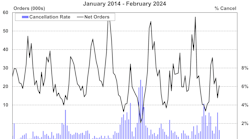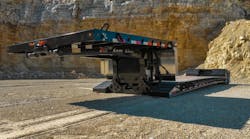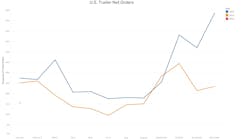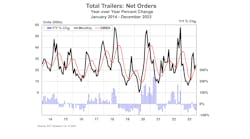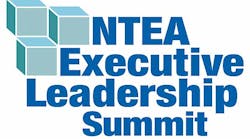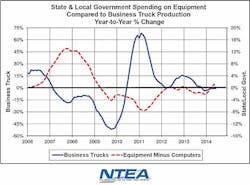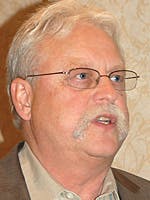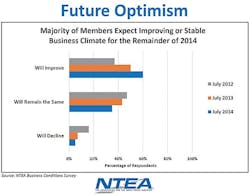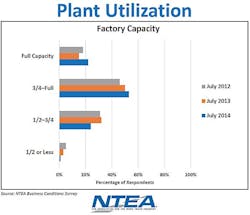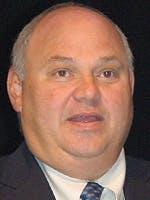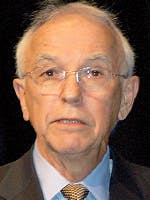The National Truck Equipment Association introduced Version 2.0 of its Business and Market Planning Summit, expanding the event to 1 ½ days, relocating it to a resort outside Las Vegas, and broadening the scope of the presentations. Here’s what 2.0 looked like, beginning with a market forecast by Steve Latin-Kasper, NTEA’s resident economist:
THE work truck industry should remain strong and outperform the US economy next year, according to Steve Latin-Kasper, director of market data and research for the National Truck Equipment Association (NTEA).
Speaking at the newly reformatted NTEA Executive Leadership Summit, NTEA’s Steve Latin-Kasper said in his presentation, “Commercial Truck and Equipment Outlook,” that as good as business has been in the truck equipment industry this year, 2015 should be even better. He said that accelerating growth in the US economy will further strengthen an already robust truck equipment industry.
US sales of Class 3-8 trucks are projected to increase by 4.9% in 2015 and 3.4% in 2016.
Latin-Kasper is convinced that there is still room for growth as a large number of older trucks remain in service. Customer groups such as state and municipal governments continue to grow, with spending projected to increase by 4% in 2015. Demand should remain high as both consumers and businesses have plenty of cash to spend.
The industry should benefit from a relatively low interest rates and available credit. Inflation is expected to remain low, even with a possible uptick in 2015.
He added that cost for the raw materials used for producing truck bodies and equipment should remain favorable, at least through the first half of next year. Hot-rolled sheet/strip is expected to remain at the same price, while cold-rolled sheet/strip and hot-rolled plate/bar will experience only very modest increases.
A major challenge next year will be the continued shortage of qualified technicians. Other than that, most of the downward pressure will be on those who export work trucks. One reason—the strong US dollar is making American goods more costly for customers in other countries.
He said the market was expected to grow from $73.8 billion in 2013 to $82 billion in 2014, with total work truck industry shipments going from $110 billion to $121.7 billion.
The Transformation of Work Trucks into Integrated Work Systems
Moderated by Rob Stevens,
VP of strategy, ROUSH CleanTech
Stevens said the work trucks of the future are quickly becoming a reality, and as more advanced technologies and innovations enter the market, industry companies will face new changes and challenges.
Rob Stevens led a panel of OEM representatives and fleet managers discussing technology integration in truck chassis and truck-mounted equipment.
“We’ve really come a long way from where truck upfitting began,” said Stevens. “There is a lot of technology coming at us, and integrating our systems so that we can upfit vehicles will be key heading into the future.”
Covering the fleet perspective, Tony Orta, asset manager of fleet services for Southern California Gas Co, Sempra Utilities, addressed the need for fleets to understand how to best leverage new technologies and how their costs will be affected.
“The bottom line is that we’re looking for supplier partners that can help us understand the total value,” he said. “We’re constantly meeting with our clients to find out the job they need to perform—and we need to make sure we’ve tapped into the right type of supplier that’s educated, gets to know our fleet and customers, and helps us come up with those types of solutions.”
Orta said that in his fleet, it’s important to know what’s coming to market so that he can communicate to internal clients what can be incorporated into the fleet. He said he relies on his supplier partners to help him monetize and qualify potential technologies in order to make a total cost of ownership proposition and get the right features into the vehicles being purchased.
“Our customers want it all but don’t want their work methods to be disturbed, and we have to find ways to aim for that,” he said. “We need to understand how we can best leverage everything out there in terms of specs and products that can add value. How can we work together to understand acquisition costs, long-term maintenance costs and product life? The best way to help customers is to ensure they understand the value of the product and service being provided.”
Doug Powell, medium-duty market manager for Kenworth Truck Company, outlined how technology has transformed Kenworth trucks over the years, including the advent of NavPlus, the factory-installed navigation, diagnostics and communication system.
Powell also discussed advancements in 3D technology, including a custom frame layout option, which enables customers to lay-out a 3D CAD model and specify clear spaces and crossmember/air dryer/tank locations as well as special frame drilling patterns.
“We pride ourselves on being a custom truck builder, offering the capability you need for space,” he said.
On the electronic side, Powell covered advancements in CAN bus connectivity, including a more body builder-friendly interface that makes it easier to put body systems right into Kenworth’s CAN bus system. He showed examples of harness options to help body builders, highlighting various connectors that will work for truck bodies.
“Ease of upfit is our goal,” he said. “There has been much growth in this area to help body builders integrate into our trucks.”
Going forward, Powell said Kenworth is focusing on research and development. He reported that the OEM is growing its engineering staff, especially in the electrical programming software side, which is where technology is heading.
He said there will be more advancements to NavPlus, with more in-house programming and direct contact with body builders to ensure their needs are incorporated from the start. Powell also touched on emissions, saying 2017 will bring improvements in chassis packaging, which could bring back some body builder space that has been occupied by previous EPA changes.
John Davis, chief nameplate engineer for Ford Commercial Truck, highlighted the OEM’s commercial vehicle strategy, a three-pronged approach involving flexible utility, mobility alternatives, and connectivity.
Regarding flexible utility, Davis said Ford aims to provide broad vocational applications in a full vehicle lineup for all needs.
“From our perspective, one of the ways we provide integrated working systems to our customers is by providing commonality, interface and similarity from vehicle to vehicle,” he said. “We want to provide a continuum across vehicle lines by improving flexibility and reducing the number of platforms.”
He said that similar architecture and shared componentry would offer the ability to engineer and produce vehicles more efficiently as well as offer a consistent interface for customers.
In the case of actual product design, Davis said Ford is looking at moving components out of the way and giving free space to upfitters. He discussed offering a clean cab to axle and upfit prep packages as well as the accessibility of vehicle modification data and information. Specifically, he cited Ford’s body builder advisory service and hotline, and available CAD data.
From a connectivity standpoint, Davis discussed near-term goals to build on SYNC and Ford Crew Chief/Telematics offerings. Mid-term objectives involve enhancing My Ford Mobile connectivity used on electronic vehicles, which offers on-board capability for charging and operational efficiency as well as the ability for remote interface through a cell phone app. Long-term, the OEM will focus on fully integrated connectivity through Ford Telematics, enabled in part with Telogis. This technology will help measure fleet use, energy, safety, and more, with a data source telecasting that information.
Kelly Frey, vice president of product marketing at Telogis Inc, highlighted the amount of data that can be collected with telematics and how it brings value. Today, a number of OEMs have implemented telematics, navigation, and Hours of Service solutions from Telogis based on end-customer needs.
“We see a lot of great stuff where big data is coming together to alert drivers if they’re going into an area where there is a roll-over situation so that they can reduce engine speed,” he said. “In the future, it’s not that hard to believe that the driver will go down the road not even paying attention because the vehicle is doing it for him.”
He said many other driver concerns will be taken care of down the road through vehicle infrastructure and V2V (vehicle-to-vehicle) connectivity. Driver performance monitoring will not be so critical, but keeping the vehicle up and productive will be.
Frey also discussed the vehicle as a hub concept of having one internet connection but the ability to hang multiple devices off of it. Essentially, the vehicle becomes a hot spot. He said he’s excited about the application across different verticals. For example, an RFID scanner in a service van could alert the office and driver if the vehicle leaves the field without all of its equipment.
Some currently available tools are real-time alerts, mobile apps, a driver coach, plan versus actual reporting, ETA/appointments, and predictive maintenance. Key zones of improvement involve safety, operational costs, and helping employees make better decisions, such as reducing speed. Plus, if there are certain areas where improvement is needed, on-demand training videos are available on a mobile device as well.
With all of the technology, information, and advancements making headlines today, how do you sort through it all as a supplier? Ken Gilles, manager, truck ordering services for GE Fleet Services, overviewed the importance of an upfitter’s ability to help customers understand how to integrate these products into their vehicles.
“Beyond dollar signs, there’s some insight—1.2 TB of data comes off a vehicle in a year’s time,” said Gilles. “Vehicles are not broadcasting yet, but it’s absolutely happening in the larger hub of GE. They have a few hundred people who are working along this avenue of taking the data from all these sources and putting it into some sort of stream that you can make some sense out of. Then we can apply dollars to it and determine real cost impact for a fleet.”
Suppliers need to be aware of that cost impact for their fleet customers, Gilles emphasized. For example, he pointed out that you can take a 1% productivity gain and turn it into actual dollars and reductions in operating costs. Also, any reduction in C02 is important to consider because if you can measure it, a fleet can prove it’s satisfying its mandate to reduce emissions.
“By utilizing the data to measure the outcomes and realize the benefits, fleets can better determine the path they need to take to get where they want to be,” he said.
Commercial Truck Industry Forecast
Andrej Divis,
Head of global truck research, IHS Global Insight
Divis said that overall, the US appears to be in a solid growth position, at least for the next couple of years. What does this mean for the work truck industry? He said stronger growth in the economy supports truck sales gains in 2014 and beyond.
“Third-quarter growth remains solid, supported by a pick-up in homebuilding, a drop in imports and robust capital spending, which is accelerating in response to global market growth, replacement needs and technological advances,” he said.
The manufacturing growth outlook remains bright and is expected to stay above gross domestic product for the next three years, he said, and he anticipates that oil prices will rise in the long run, following a 2015 decrease. The other piece of the US energy equation—natural gas—has remained at a low level price-wise due to the burgeoning national supply, said Divis. He said prices will likely maintain those levels for the remainder off the business cycle.
For the NAFTA truck market going forward, Divis said that sales of small commercial trucks will continue at a healthy pace, supported by replacement demand and the emerging recovery in housing and construction. Class 1–2 will deliver slow and steady growth over the near-term, more or less in line with the recovery in household spending.
The medium-duty sector continues to gain ground, with Class 4–7 growth rates up about 13% year-to-date. Class 3 sales have experienced modest growth in 2014 and could finish the year with growth of 4–5% or more. Likewise, the Class 6–7 market segment is expected to fare well.
Heavy truck sales have been on an upswing in 2014, coming back to life with sales up 19% year-over-year after bottoming out in 2013.
“There is reason to believe the recovery will continue when you look at the backlogs, which are up double digits,” said Divis. “This market should persist in delivering strong sales as long as the OEMs can build the trucks, which we think they can.”
He said that while this sector is more susceptible to global economic impacts than the smaller truck class markets, the current trend is strong.
“Overall, the next couple of years will be great for truck demand,” said Divis. “Replacement remains the primary motivation for truck buyers, but capacity expansion is now also under way. Again, all of the risks are out there, but if things continue on this path, we’ll be in for a good stretch.”
Work Truck Industry Insights
Steve Carey, executive director, NTEA
Doyle Sumrall, managing director, NTEA
Ninety-one percent of fleets plan to acquire trucks in the coming year (a 5% increase over last year) and 33% plan to acquire more than they did last year (a 7% increase).
Those were among the key findings from the semi-annual Fleet Purchasing Outlook involving 300 fleets.
“We’ve seen a steady increase in fleets buying vehicles,” Carey said. “We’re continuing to see upside pressure on fleets stepping back into buying activity. Between the 2013 and 2014 data, fleets are getting into more expansionary mode as opposed to replacement or contraction mode on vehicles. When we first started the recovery, we didn’t see fleets going into an expansionary phase. They were replacing what they had to and pushing idle inventory back into use. We believe they’ve worked that through the system and are going back into an expansionary process.”
Employment levels have stabilized since the beginning of 2014, with 58% reporting increased hiring—up from 41% a year ago, according to Business Conditions Survey involving 1699 companies.
“We’ve been seeing a pretty steady increase for three years,” Carey said.
Sixty-four percent reported increased sales volume since the beginning of 2014, and 95% expect an improving or stable business climate for the remainder of 2014.
Twenty-two percent have a plant at full capacity, a 6% increase over a year ago, and 52% are at three-quarters capacity, a 2% increase.
“We think one of the benefits of the way the recovery has happened is it’s been pretty steady and systematic, so the industry as a whole has the ability to bring capacity back online in a fairly regulated way,” Carey said. “This is anecdotal: As we travel around and talk to people, the challenges they’re having with personnel is holding down utilization levels a bit because even though they have the physical plant to get work done, they don’t have the people. The other thing is the tightening of chassis availability.”
Backlogs are creeping up a bit in what is a five-year story, he said, with 38% reporting 60 days or more in lead times, compared to 27% a year ago.
Current business challenges: federal government financial or regulatory policy (47%); local economic conditions (41%); global economic uncertainty (39%); continuation of the poor housing market (32%); low consumer confidence (22%); tight credit market (11%).
Areas of concern: finding and keeping qualified employees (70%, up from 58% in January); higher cost of doing business (61%); changing industry conditions (40%, down from 55% in January); increased competition (29%); access to truck chassis (24%, up from 11%); growing my business (23%); complying with regulations (22%); changing customer expectations (14%); and access to working capital (12%).
“The story on personnel is a thread of conversation we have with every company we visit,” he said. “Everybody is fighting the same battle and having a tough time recruiting people and bringing them to the organization.”
According to the Channel Relationship and Market Trend Report, there is a change in manufacturers’ sales approach, with 26% having an increased reliance on and 25% having an increased reliance on direct selling.
Geopolitics in North America and How They Relate to You
Peter Zeihan,
President/founder, Zeihan on Geopolitics
Zeihan rejected the notion that the US has reached its peak and that countries like China and Russia will overtake the nation. With a river network over useable land, double the ocean access, and the largest market and military, Zeihan emphasized America’s position of power.
He also detailed the rise of shale, the output of which is mainly produced and consumed by America.
“By producing our energy locally, we shave money off of transporting, and we don’t have to worry as much about what’s going on in other regions,” said Zeihan.
“Here is the simple bottom line of electricity prices. Oil is easy to transport, and because those prices are so strong, everyone is drilling for oil, not natural gas. Natural gas is harder to move and is considered a waste product. As such, electricity prices have flat-lined.
“As long as shale is a viable industry, it is destroying the very demand that makes it possible.”
He said that as Baby Boomers retire and aren’t driving as much, there will be even less energy consumption over the next 15 years—or maybe longer. He predicted that North America is only 14 months away from achieving functional energy self-sufficiency.
He said other countries can’t do what the US is doing with shale because five things are needed for success: capital for the wells; engineers who can operate those wells; a legal system so that local landowners can have property rights; pipes and market; and handy placement.
“We are one of only five countries with a national transport grid for natural gas,” he said. “It would take 30 to 40 years to put these systems in place anywhere else—if they started today.”
He said Canada has a problem with shale because the country’s pipelines all end in the upper Midwest and the country is selling crude into an area that the shale market has already dominated.
“They’re now selling to the most oversupplied market in the planet, and prices are not good,” he said.
A remedy for this issue is the Keystone XL pipeline expansion, which would take more than 800,000 barrels per day of Alberta tar sands crude to refineries on the Texas Gulf Coast. No final decision has been reached on this proposed project, though, and there is no approval date in sight.
On the other hand, Zeihan predicted that Mexico will be the economic success story of the 21st century for several reasons, the first of which is American shale. Seven major lines that will bring shale gas into the heart of the Mexican economy will be finished in the next three years, making it the largest bilateral energy relationship in history, he said. Also, Mexico has a younger demographic, which means a big labor market and growing consumer base. Additionally, Zeihan noted the impact of the drug war on the Mexican economy as cartel supply chains continue to diversify into other countries.
As for how the overall global deck is stacked against the US, Zeihan referenced demographics and consumption in America as compared to other countries, saying the developed world will face difficulties associated with aging populations.
“Yes, the US will face a decade of doing more with less, but we’re in the best position compared to other countries,” he said. “We have a consumer market bigger than almost everyone else’s put together, and larger investment capital. We are the only market that will last the next year-on-year for the next 60 years.”
He said that if you put together the market, access, money, and security, the US is in a great position for a long time to come.
Macroeconomic Forecast for the Work Truck Industry
Mark Vitner,
Managing director/senior economist, Wells Fargo Securities, LLC
The forecast for continued US economic growth is “relatively optimistic,” he said.
Real gross domestic product growth has accelerated, picking up on a 2.4% basis, with expectations for a 3% average pace over the next two to three years. Also, the unemployment rate, one of the most readily identifiable economic variables, has fallen. The improvement in this rate has been significant enough that many of the emergency measures put in place during the recession have been wound down.
Vitner compared the current state of the US economy to the third quarter of a football game, saying we’re past the first half (of the expansion).
“I like our position,” he said. “We don’t have the same defensive policies anymore. Most of the pent-up demand of the consumer has already been met, and the auto cycle is close to topping out.”
He added that economic growth is broadening, starting initially in the energy and technology sectors and now continuing in the commercial construction and single-family home-building markets.
Regarding timing for the next recession, Vitner explained that the average business cycle lasts just short of five years, with an approximate 59-month span between recessions. The US has experienced longer-than-average cycles, with the last three running about 7½ years.
“This puts us into 2016 when we get a new ‘quarterback’ in the White House,” he said. “The next two-and-a-half years are likely to be the strongest growth-wise that we’ve had—and we’re not writing off 2017.”
As the expansion will be a little long by 2017, Vitner predicts that the next recession will occur between mid-2016 and 2019.
Despite the solid growth position of the US, some key issues remain.
“What worries me a bit is that the global economy appears to be weaker than many realize,” said Vitner. “The IMF has come out twice and downgraded the world forecast, but the most troubling part is that it’s always six months out of date. It looks like Europe is falling back into recession. In terms of where it’s falling the hardest, it’s in the heart of Europe—in Germany and France.”
China’s growth has also slowed, he said, and commodity prices are falling.
“The biggest risk is the weakness in energy prices,” he said. “It’s inconceivable that the US can become the largest producer of oil and natural gas and not be hurt by a substantial decline in prices.”
Vitner said that at some lower price point, energy companies could begin shuttering production. While many of the big energy states have other industries to tide them over, energy still plays a large part in their economy.
Despite these concerns, Wells Fargo is still sticking to its 3% growth forecast in 2015 and 2016. Vitner said that while slower global growth will hurt in some ways, the US is better able to withstand it than most other nations, as it is more domestically, not globally, focused. However, Vitner pointed out that the next six months are critical because that time period is when the most abrupt policy adjustments and changes overseas will be experienced.
For the housing market, Vitner expects a continued gradual recovery in home-building, with apartments playing a larger role than in previous cycles. He said that home prices are now 92% above their previous peak. However, the total number of homeowners has decreased, even though prices have recovered. Home sales appear to be sputtering because investors are pulling away and traditional buyers aren’t coming back as quickly, said Vitner.
Data-Based Decision-Making in Today’s Truck Market: An OEM Perspective
Kristen Santos
Manager, market planning and analysis, Daimler Trucks North America
Santos said that based on DTNA’s research and metrics, 2015 shapes up as a “really strong” year for the truck market.
“We look at this as investment consumption is supposed to pick up,” she said. “2016 remains a source of contention within our company. I say it could be slow. My colleagues say it could be strong.”
Santos said her department handles customer data management, managing 13.8 million truck records and trying to translate that to prospects for dealers. Her department produce a yearly 10-year forecast across all the GVWs and countries DTNA sells to.
“We have a ton of data at Daimler,” she said. “How are we tying that all together in one bundle to understand customers’ lifecycle? How are we using it for product development and how are we using it to drive insights within the organization? Unless you have data that’s driving conversations about what to do next, it’s essentially useless.
“A lot of it has to do with combining all these trends and then backing into whether you think the market’s going to be positive and whether fleets say they will be buying and then figuring out our percentages from there.”
She mentioned “big data,” which is a term for a collection of data sets that are so large and complicated that they can’t easily be dealt with by using traditional data-processing applications. She said there is no common definition, so DTNA has to decide what’s relevant.
She said there are three potential focus areas:
• Total cost of operations (TCO).
“It’s extraordinarily difficult with a company of our size because TCO for some of our customers is relatively simple. You’ve got big fleets that have an extremely sophisticated system for tracking fuel efficiency systems, and they know every option on your truck, but you also have owner-operators who don’t know anything. They mail paperwork to their sister-in-law in Ohio. Then you get into body builder and truck operations, and that’s a whole different arena because there are so many different permutations of a truck and how it’s used.”
• Configuration optimization.
“We’ve got on one side the fleets who are truly sophisticated with how they spec trucks, and on a total other end we’ve got somebody who’s spec’ing it because that’s the way their grandfather did it in 1958. So we kind of have to figure out how our customers understand the best way to do that. And the best way is to run our spec information and find out the lifespan of trucks and things like that. But right now, all of those systems live in different places.”
• Customer relationship management.
“Managing it from start to finish is a complicated thing.”
She said the big data challenges are:
• Infrastructure (technology platform/tools).
• Organizational talent (the data scientist).
• Information accessibility of the organization.
• Decision-making acceptance with big data.
• Social media and web analytics.
• Call center data.
Would You Do Business With You?
Sam Geist
President, Geist & Associates Inc
Why should a customer get in a car and drive past three businesses to come to you? How do you differentiate your company to the individual who makes the final purchase decision?
Geist challenged attendees to take a realistic look at their organizations and consider whether or not they would do business with themselves.
“Differentiation is a competitive advantage,” said Geist. “How do you compete? What is your point of difference?”
He said that many companies would answer these questions with “price.” But in today’s business climate, people and approaches are different. The model that many leaders grew up with has changed, and most businesses are locked into yesterday’s way because it’s easier.
“When you take price off the table, what do you have left? What do you stand for?” Geist said. “How many of you thought about the word ‘service’ or ‘value’ or ‘quality’? Sorry, those are entry-level tools today and will get you a grade ‘C’ in today’s business climate. You think your competitors aren’t doing the same thing? It’s the same words and the same graphics.”
Change is tough, he said, but not changing is terminal. He stressed the importance of “customerizing for one,” of making each individual feel as though they’re your only buyer. He asked the attendees to consider their primary customer and why they’re doing business with them.
“What value did you offer this year? What new things did you bring to the table?” he said. “You think these aren’t questions they’re asking themselves? The closer you get to the highest needs of your customer, the more they will want to do business with you. It’s about partnership.”
Geist also cited results of recent research into key customer issues, with the top three identified as stress, time, and trust.
“People do business with companies they consider trustworthy,” he said. “How do we make trust a tangible, touchable thing so that it’s different from price? People love to sit there and strategize, but actual profits come from execution. Execution is not part of the strategy—it is the strategy. If you execute, people will want to do business with you and recommend you to others because you’ve made it easier for them.”
Geist challenged attendees to think of one thing that could improve their overall execution and said that leaders are responsible for taking the action to drive their companies forward.
“We have to be realistic, to look at our business with clear eyes and not rose-colored glasses,” he said. “You think your business is good? Great, now you need to make it better.” ♦
